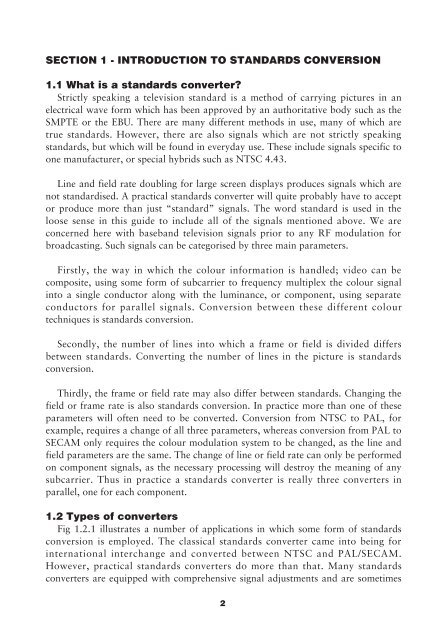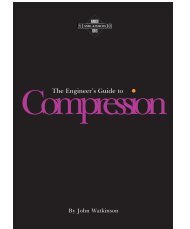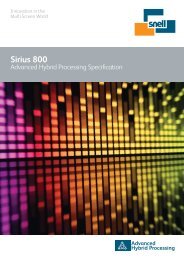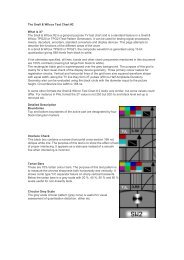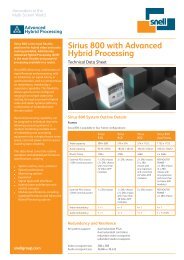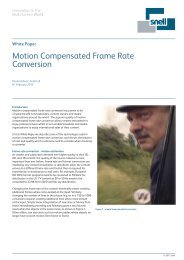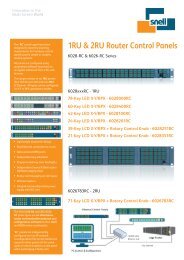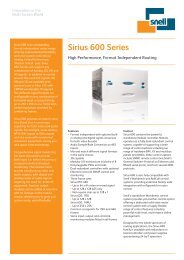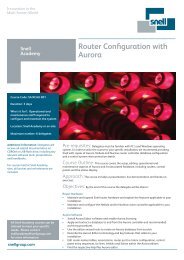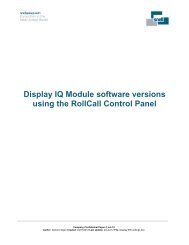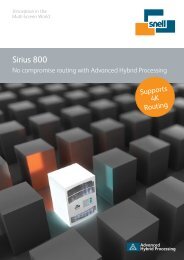The Engineer's Guide to Standards Conversion - Snell
The Engineer's Guide to Standards Conversion - Snell
The Engineer's Guide to Standards Conversion - Snell
Create successful ePaper yourself
Turn your PDF publications into a flip-book with our unique Google optimized e-Paper software.
SECTION 1 - INTRODUCTION TO STANDARDS CONVERSION<br />
1.1 What is a standards converter?<br />
Strictly speaking a television standard is a method of carrying pictures in an<br />
electrical wave form which has been approved by an authoritative body such as the<br />
SMPTE or the EBU. <strong>The</strong>re are many different methods in use, many of which are<br />
true standards. However, there are also signals which are not strictly speaking<br />
standards, but which will be found in everyday use. <strong>The</strong>se include signals specific <strong>to</strong><br />
one manufacturer, or special hybrids such as NTSC 4.43.<br />
Line and field rate doubling for large screen displays produces signals which are<br />
not standardised. A practical standards converter will quite probably have <strong>to</strong> accept<br />
or produce more than just “standard” signals. <strong>The</strong> word standard is used in the<br />
loose sense in this guide <strong>to</strong> include all of the signals mentioned above. We are<br />
concerned here with baseband television signals prior <strong>to</strong> any RF modulation for<br />
broadcasting. Such signals can be categorised by three main parameters.<br />
Firstly, the way in which the colour information is handled; video can be<br />
composite, using some form of subcarrier <strong>to</strong> frequency multiplex the colour signal<br />
in<strong>to</strong> a single conduc<strong>to</strong>r along with the luminance, or component, using separate<br />
conduc<strong>to</strong>rs for parallel signals. <strong>Conversion</strong> between these different colour<br />
techniques is standards conversion.<br />
Secondly, the number of lines in<strong>to</strong> which a frame or field is divided differs<br />
between standards. Converting the number of lines in the picture is standards<br />
conversion.<br />
Thirdly, the frame or field rate may also differ between standards. Changing the<br />
field or frame rate is also standards conversion. In practice more than one of these<br />
parameters will often need <strong>to</strong> be converted. <strong>Conversion</strong> from NTSC <strong>to</strong> PAL, for<br />
example, requires a change of all three parameters, whereas conversion from PAL <strong>to</strong><br />
SECAM only requires the colour modulation system <strong>to</strong> be changed, as the line and<br />
field parameters are the same. <strong>The</strong> change of line or field rate can only be performed<br />
on component signals, as the necessary processing will destroy the meaning of any<br />
subcarrier. Thus in practice a standards converter is really three converters in<br />
parallel, one for each component.<br />
1.2 Types of converters<br />
Fig 1.2.1 illustrates a number of applications in which some form of standards<br />
conversion is employed. <strong>The</strong> classical standards converter came in<strong>to</strong> being for<br />
international interchange and converted between NTSC and PAL/SECAM.<br />
However, practical standards converters do more than that. Many standards<br />
converters are equipped with comprehensive signal adjustments and are sometimes<br />
2


